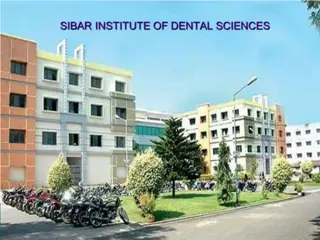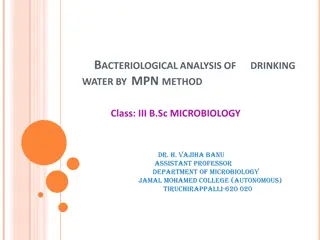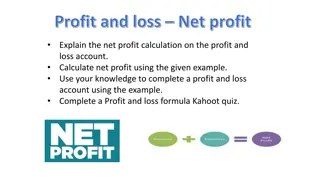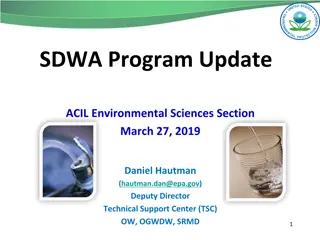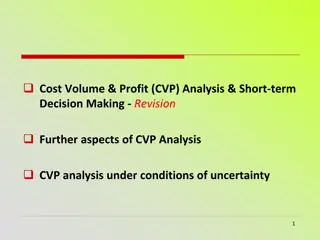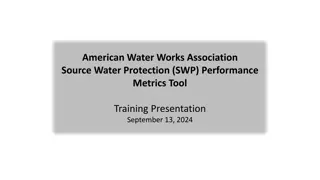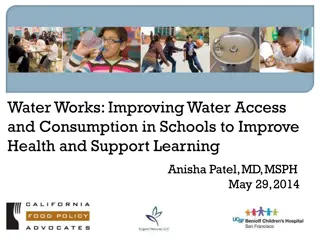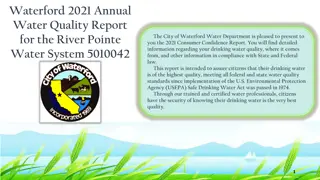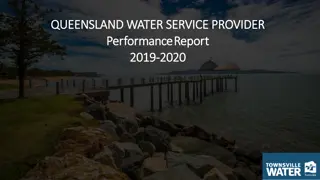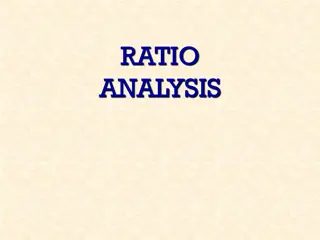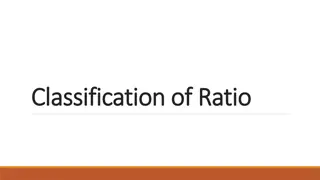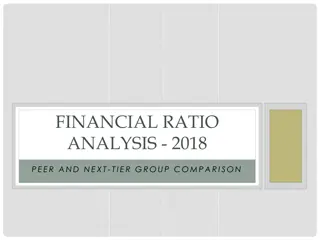Application of Profit Ratio Function in the Drinking Water Sector
The application of the profit ratio function in the drinking water sector is discussed, focusing on optimizing value functions and measuring productivity change in the Netherlands. The function analyzes input demand, output supply, and profit ratios, offering insights into efficiency and profitability in non-competitive markets. Various theoretical and empirical perspectives are explored, highlighting challenges with scale inefficiencies and zero profits. References to relevant literature and studies provide a comprehensive overview of the topic.
Download Presentation

Please find below an Image/Link to download the presentation.
The content on the website is provided AS IS for your information and personal use only. It may not be sold, licensed, or shared on other websites without obtaining consent from the author.If you encounter any issues during the download, it is possible that the publisher has removed the file from their server.
You are allowed to download the files provided on this website for personal or commercial use, subject to the condition that they are used lawfully. All files are the property of their respective owners.
The content on the website is provided AS IS for your information and personal use only. It may not be sold, licensed, or shared on other websites without obtaining consent from the author.
E N D
Presentation Transcript
Profit ratio (Return to the outlay) function An application to the drinking water sector June 14, 2017 EWEPA, London Prof. Jos LT Blank Dr. Alex AS van Heezik www.ipsestudies.nl IPSE Studies
Outline Optimizing some value function An alternative: the return to the outlay function (profit ratio) Literature Specification Input demand and output supply functions Estimating Application Drinking water sector in the Netherlands Data Model specification Results How to proceed 2 IPSE Studies
Duality diamond (Fre & Primont 1995) (w,p) IC(p/R, w) IR(w/C, p) C(y,w) R(x,p) IDi(p/R, x) IDo(w/C, y) Di(x, y) Do(x, y) T 3 IPSE Studies
The profit function ? = ? ? = ?(?,?) Theoretically: It is not the ultimate productivity measure In a non-competitive market scale inefficiencies Empirically: Negative or zero profits are hard to deal with, in particular regarding the first order conditions (Hotelling s Lemma) 4 IPSE Studies
The profit ratio function (return to the outlay function) Balk, B. (2010). An assumption-free framework for measuring procuctivity change. Income and Wealth, 56(1), 33. ?? =?? ??= ?(?,?) F re, R., Grosskopf, S., & Zaim, O. (2002). Hyperbolic efficiency and return to the dollar. European Journal of Operational Research, 136(3), 671 679. pr = profit ratio p = vector of output prices y = services produced w = input price x = resources used Georgescu-Roegen, N. (1951). The aggregate linear production function and its applications to von Neumann s economic model. Activity Analysis of Production and Allocation, (13). Kumbhakar, S. C. (2011). Estimation of production technology when the objective is to maximize return to the outlay. European Journal of Operation Research, 208, 170 176. 5 IPSE Studies
1st and 2nd order conditions Homogeneous degree 1 in output prices; Homogeneous degree -1 in input prices; Non-decreasing and convex in output prices; Non-increasing and convex in input prices; ???=???? ?log(?? ?,? ) ?log(??) = ? ???=???? = ?log(?? ?,? ) ?log(??) ? 6 IPSE Studies
Drinking water sector (I) 7 IPSE Studies
Drinking water sector (II) 8 IPSE Studies
Drinking water sector (III) Funding The costs of drinking water companies are fully covered by the proceeds from the sale of drinking water; The drinking water tariff consists of a fixed amount per connection per year (fixed rate) and a variable rate for consumption per cubic meter. Regulatory environment Main legislative framework: Drinking Water Act (2011) ownership restricted to local/regional authorities (the drinking water companies are public limited companies); companies governed by local/regional shareholders (municipalities and provinces); supervision by national government with main focus on water quality, continuity (public health) and efficiency; There is a mandatory benchmarking every three years. 9 IPSE Studies
Specification Input prices: Labor (=w1); Material supplies (=w2); Capital (=w3). Technical change: Time trend Functional form: translog Output prices: Connections (=p1); Water consumption (m3) (=p2). Environmentals: Surface (km2) (=z1) Data: 10 companies 2003, 2006, 2009, 2012, 2015 10 IPSE Studies
Revenues per year 11 IPSE Studies
Revenue share per year 12 IPSE Studies
Estimates (COLS, SFA) Labor (=w1); Material supplies (=w2); Capital (=w3). Standard Connections (=p1); Water consumption (m3) (=p2). Variable Parameter Estimate A0 B1 B11 C1 C2 C11 C12 C22 D1 D11 E11 E12 F11 F12 G11 H1 trend x p1 I11 trend x w1 J11 trend x w2 J12 Error t-statistic 0,038 0,011 0,006 0,047 0,052 0,775 0,776 0,777 0,025 0,037 0,011 0,013 0,011 0,018 0,006 0,004 0,001 0,004 0,005 Inflation Corrected t-stat constant p1 p1*p1 w1 w2 w1 x w1 w1 x w2 w2 x w2 z1 z1 x z1 p1 x w1 p1 x w2 z1 x w1 z1 x w2 z1 x p1 trend 1,761 0,350 0,170 -0,333 -0,360 -0,013 -0,115 0,058 0,060 -0,057 0,001 0,008 -0,081 -0,016 0,008 0,001 0,002 0,001 0,000 46,617 32,443 28,903 -7,034 -6,895 -0,017 -0,148 0,075 2,374 -1,550 0,118 0,596 -7,293 -0,892 1,301 0,269 2,179 0,249 0,097 Population density (=z1) 2,27275 1,94061 3,09396 3,12043 2,6782 2,69603 2,71155 3,33951 3,32596 2,78488 2,81588 3,14094 3,15892 2,86592 14,275 14,894 -2,273 -2,210 -0,006 -0,055 0,028 0,711 -0,466 0,042 0,212 -2,322 -0,282 0,454 Note: homogeneity reqs. implemented by choosing numeraire (p2 and w3) SFA no convergence 2,29464 2,71292 2,71157 0,949 0,092 0,036 13 IPSE Studies
Results (COLS, SFA) Requirements R2PR function R2ISH1 R2ISH2 R2OSH1 non-decreasing in p convex in p* non-increasing in w convex in w* 0,93 0,60 0,20 0,94 Other outcomes technical change output biased technical change input biased technical change input-output substitution 14 IPSE Studies
Results (efficiency per year) 15 IPSE Studies
Results (efficiency score per company) Company 16 IPSE Studies
Results (technical change) 17 IPSE Studies
Results (population density and PR) 1.2 Effect on profit ratio 1 0.8 0.6 0.4 0.2 0 0 0.5 1 1.5 2 2.5 3 3.5 Population density 18 IPSE Studies
Results (scale economies) Efficiency Connections 19 IPSE Studies
Concluding remarks Profit ratio interesting approach; Empirically easier to handle than profit function; Application to drinking water plausibel results; Work in progress: Other estimation methods; More applications; Deriving other (constrained) models decomposition. 20 IPSE Studies






